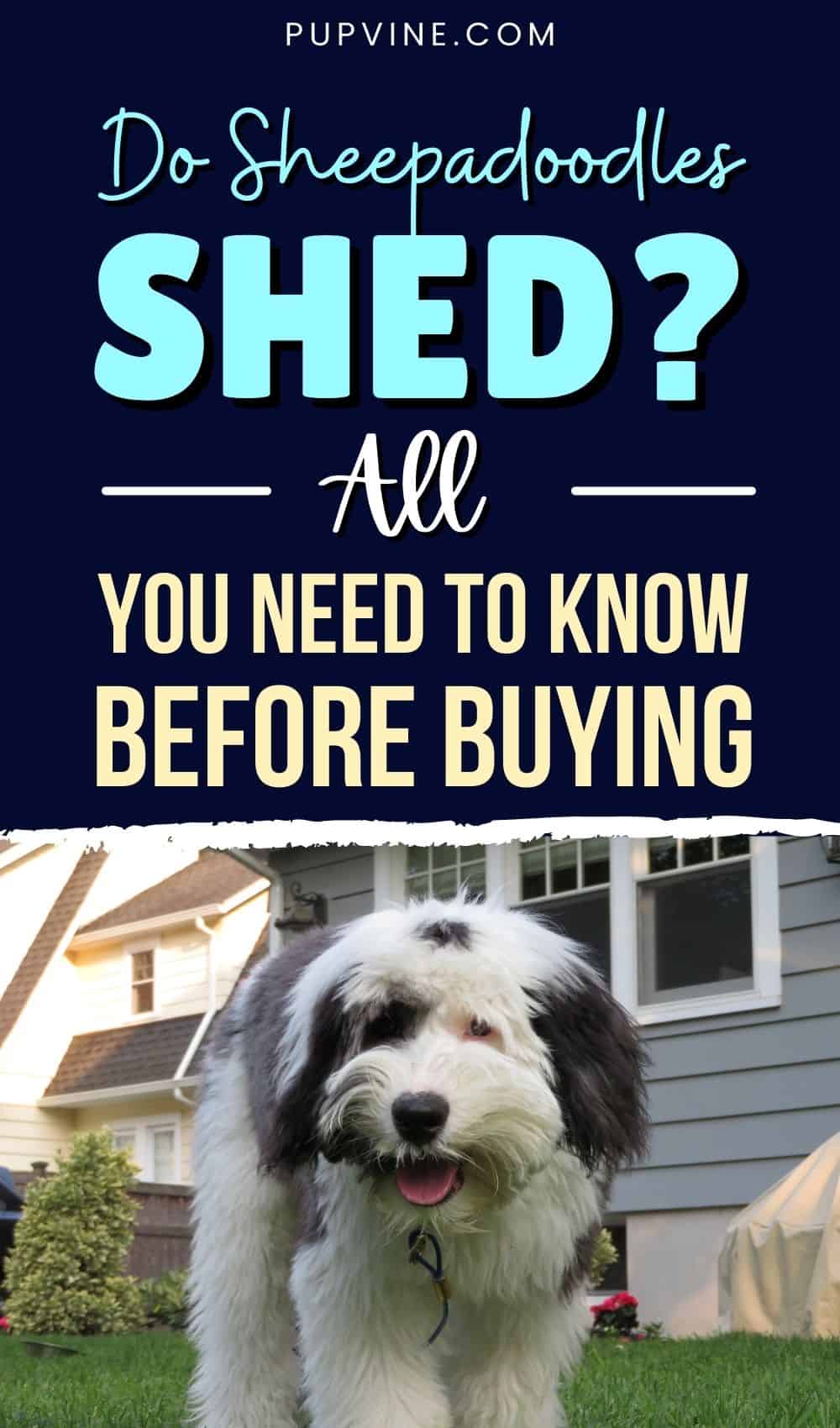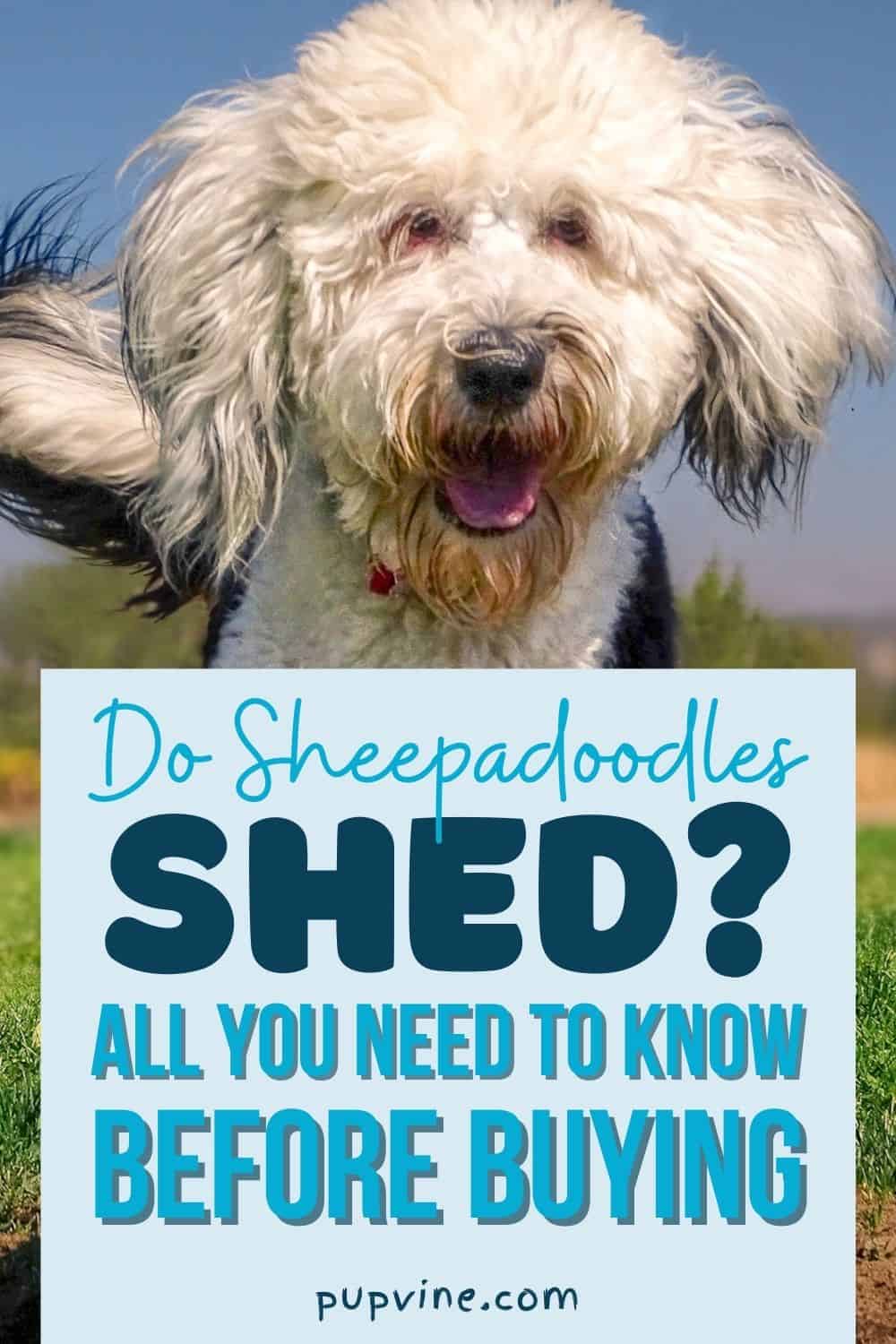Let’s get straight into myth-buster mode and put the truth out there from the start: there is no such thing as a non-shedding dog! It doesn’t matter who says otherwise, whether it’s a kennel club, a blogger, or a breeder, all dogs shed hair to some extent.
There, we’ve said it. So, this sort of answers our main question, Do Sheepadoodles shed?
According to our bold claim, it seems that yes, Sheepoodles do shed. However, it would be wrong to end there, especially when there’s so much more to learn about this wonderful designer dog!
If you’ve seen the hype about the Sheepadoodle dog and are considering getting one for yourself, then this article was made just for you. Not only will you learn all about that famous hypoallergenic coat, but you will also find all the information you need to help you decide once and for all whether this is the dog for you.
So, we’ll explore this dog’s coat, obviously, and take an in-depth look at all the aspects of owning a Sheepadoodle, including grooming and care, health issues, training, and temperament.
To begin with, we’ll start with the basics…
Why Do Dogs Shed Hair?

As we have already learned, all dogs will shed hair (or fur) at some point. It’s a simple biological fact. The dog’s coat is there to protect it from the elements, whether it is hot, cold, or wet conditions. Different dog breeds suit various environments, but all of them react to the seasons. More accurately, they react to the changing light levels as the seasons change.
A dog’s hair goes through three stages in its life cycle: anagen, catagen, and telogen.
The first stage is where the hair actively grows. The second stage is when the hair has finished growing, and the third is when it falls away to be replaced by new hair.
This was more important in the days when dogs lived outdoors for the most part. The coat would thicken to protect them from the freezing conditions of winter, and thin out as the weather warmed in the spring.
These days, as most dogs spend the majority of their time indoors, often with central heating, their coats are more likely to shed fairly evenly throughout the year. However, many breeds still blow their coat twice annually, in the spring and fall. This is more noticeable in dogs with a double coat, with coarse hair on top and an undercoat of fur beneath. It is usually this lighter, fluffy fur that you notice around your home, and which seems never-ending when you brush them.
Sometimes, it looks as if you could make another dog out of the mountain of fur that brushes out!
Now, we come to the Sheepadoodle coat. You might see claims on blogs or other websites stating that this designer dog has a low-shedding or even a non-shedding coat. You might also read that they don’t require much grooming because they have a low-maintenance, single coat.
The truth is that while some Sheepadoodles may be low-shedding and have a single coat, it all depends on which genes have been inherited by the pup. Do Sheepadoodles shed? Yes, but the amount will vary according to the type of coat they inherit from their parent breeds.
This brings us nicely to the next section.
What Is A Sheepadoodle?
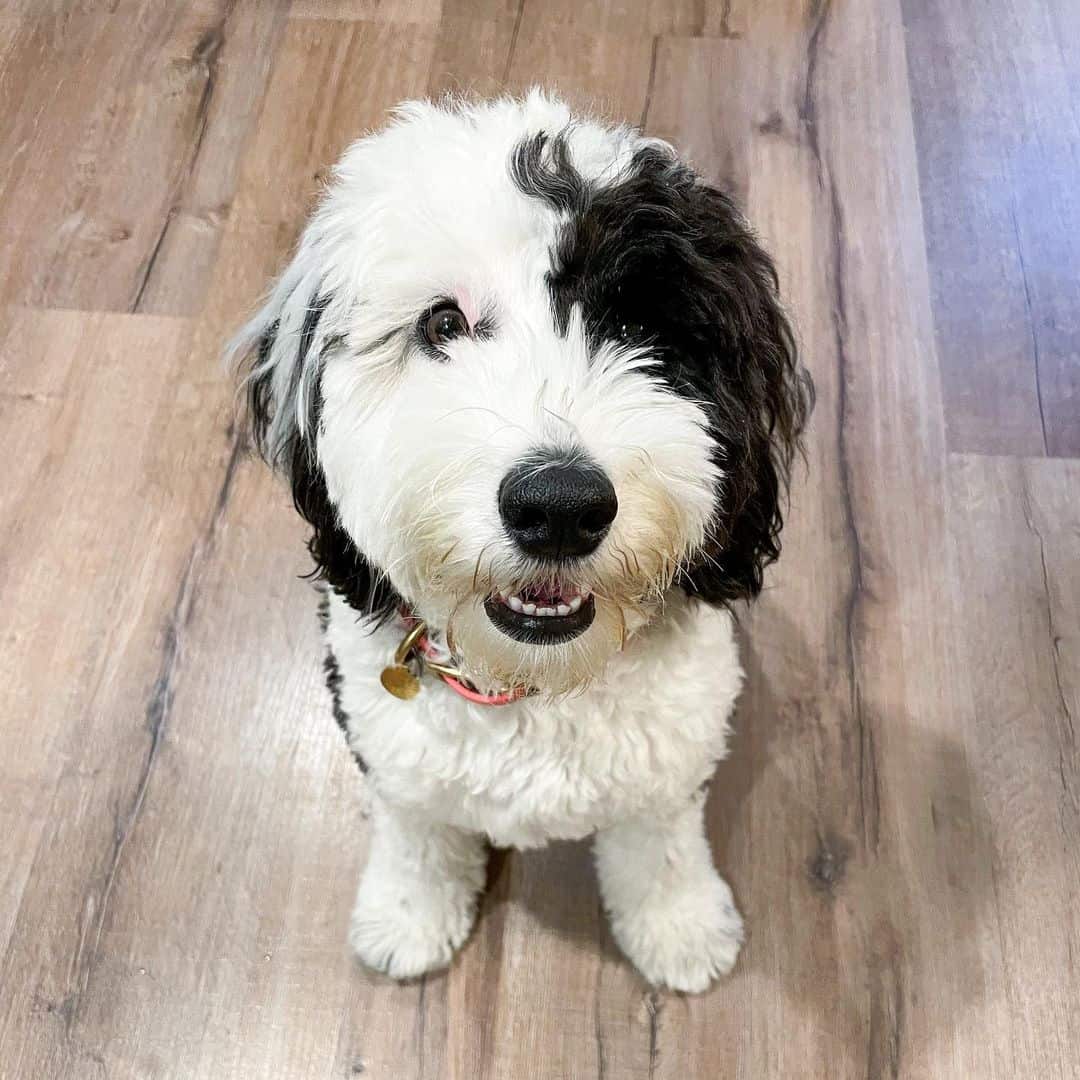
Photo from: @rorythesheepy
This crazy, fun-loving goofball is a crossbreed of the purebred Old English Sheepdog and the Standard Poodle, also called the Sheepdoodle and the Sheepapoo, among others. If you’ve seen one or even met one before (which is likely and is probably why you’re reading this!), you’ll know how unbelievably cute they are. They’re just one big loveable ball of fluff.
You might assume, then, with all that long hair, they’d be a nightmare when it comes to shedding, and therefore, they should be avoided by allergy sufferers. Then again, you might have heard that they’re hypoallergenic, which is great news if you have allergies.
However, the truth is a little more complicated than that. We’ll explore this further along, but for now, we’ll learn more about this teddy bear dog.
We can’t be sure when Sheepadoodles first appeared, but it would be some time after the first Doodle dogs came onto the scene in the early 1990s, with the Labradoodle, closely followed by Goldendoodles. From that time onwards, these designer breeds have seen a remarkable increase in popularity, and it’s easy to see why.
It’s difficult to predict the exact size that Sheepadoodle puppies will reach when fully grown. Much of this will depend on the size of the parents as this guide to average sizes might help to illustrate:
| Height | Weight | |
|---|---|---|
| Male Standard Poodle | 18″–24″ (46–61 cm) | 45–70 lbs (20.4–31.75 kg) |
| Female Standard Poodle | 18″–24″ (46–61 cm) | 45–60 lbs (20.4–27.21 kg) |
| Male Old English Sheepdog | 22″–24″ (56–61 cm) | 70.54–99.2 lbs (32–45 kg) |
| Female Old English Sheepdog | 20″–22″ (51–56 cm) | 59.52–80 lbs (27–36 kg) |
| Male Standard Sheepadoodle | 21″–22″ (53.3–55.88 cm) | 60–75 lbs (27.2–34 kg) |
| Female Standard Sheepadoodle | 19″–21″ (48.26–53.3 cm) | 45–60 lbs (20.4–27.2 kg) |
Remember; these heights are measured at the withers (shoulder) and not the head, so your adult Sheepadoodle will be taller than the given figure, possibly up to 28″ tall. The above chart shows the average size using a Standard Poodle, but smaller-sized dogs can be bred when Toy Poodles or Miniature Poodles are used.
Because of the different parent breeds used, there are four basic types of Sheepadoodle: the f1, the f1b, the f2, and the Mini Sheepadoodle. Don’t be too alarmed by these names; they’re just a code that tells us what percentage of each breed has gone into producing the pups. For example, an f1 Sheepadoodle is a first generation dog, with the ‘f’ meaning ‘filial hybrid’.
This can get confusing, so always feel free to ask Sheepadoodle breeders if you have any questions. Reputable breeders will be very pleased to explain it to you, and you’ll have a better idea of what traits your pup will have. As a rule, most Sheepadoodle owners prefer a dog with stronger Poodle genes.
This mixed breed dog can have a long, moderately dense curly or wavy coat in the following colors: cream, brown, black, gray, blue, red, or white.
Speaking of this coat, let’s take a closer look.
Are Sheepadoodles Hypoallergenic?
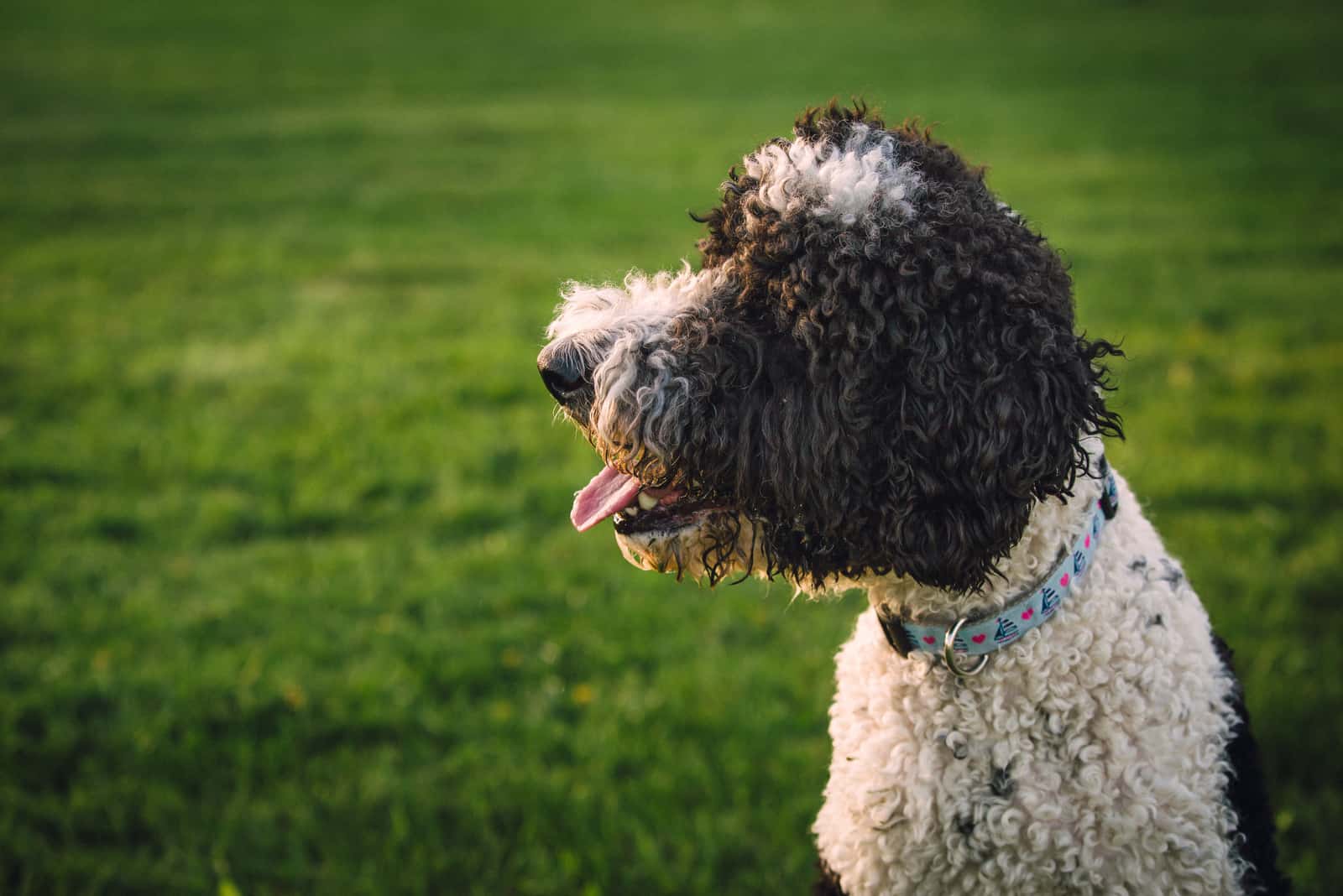
It depends on what you mean by hypoallergenic, as there’s a lot of misunderstanding surrounding this term!
Sheepadoodles, because of their Poodle parents, have earned a reputation for being hypoallergenic. So, what’s the truth?
To answer this properly, we need to give this question the same treatment as our original one, Do Sheepadoodles shed? Countless blogs and websites run by breeders, kennel clubs, and dog-enthusiasts claim that certain breeds are hypoallergenic. What they often mean is that allergy sufferers will be safe to welcome this breed into their homes as the dog is effectively allergen-free.
Once again, we have to bust some myths by pointing out that all dogs carry allergens. Most people still assume that it is dog hair that they’re allergic to when, in fact, it is the proteins within the dog’s saliva, urine, and dander (dry flakes of skin) that cause an allergic reaction.
The human body can withstand these for many years, but can suddenly develop an allergy. For some reason, the immune system recognizes these proteins and decides that they are potentially harmful, and attacks them.
The brain sends a signal to the mucus membrane in the nose, telling it to increase mucus production. Histamine is produced, which causes itching, swelling, and redness of the skin. Blood vessels become constricted, and the throat can swell in extreme cases, known as anaphylaxis.
These reactions are all designed to protect the body from a substance that is actually, in most instances, harmless!
You can see why people would want a dog that is labeled as hypoallergenic. The trouble is, this term is misleading and often used incorrectly. What it actually means is that you are less likely to have a reaction, not that it is ruled out completely.
Even so, studies have proven that dog allergens are often found in higher volumes within the homes where so-called hypoallergenic dogs live than in those of other breeds!
This is important, as it is linked to our main question, Do Sheepadoodles shed?
Dogs that shed less will obviously leave less hair around your home. The Poodle’s curly coat traps any loose hairs within it, which means that effectively, they shed less! Hair that sticks to carpets, furniture, and clothes has more of a chance of coming into contact with people in the house. This hair will have loose flakes of skin as well as saliva, and even small amounts of urine (as a result of the dog cleaning itself).
The Poodle’s coat is made from hair rather than fur, as are most single coats. Dogs with double coats have a thick layer of fur beneath the topcoat, and this is the one that blows twice a year.
So, the Old English Sheepdog Poodle mix can inherit this coat, which is why they have been hailed as one of the best dogs for allergy sufferers. The curls are tight, and they trap the loose hair.
However, there’s a chance that puppies may take after the Old English Sheepdog parent, with a wavy coat and loose curls. This will allow dead hair to fall off and attach itself to your carpet and furniture. Not so great for allergies!
Both coats are probably less likely to contribute to allergies, but they come with a downside: the curly Poodle coat needs extra brushing to avoid matting, and the wavy coat (although easier to maintain) needs extra brushing to reduce the amount of dead hair that’s dropped around your home.
Do Sheepadoodles Have Hair Or Fur?
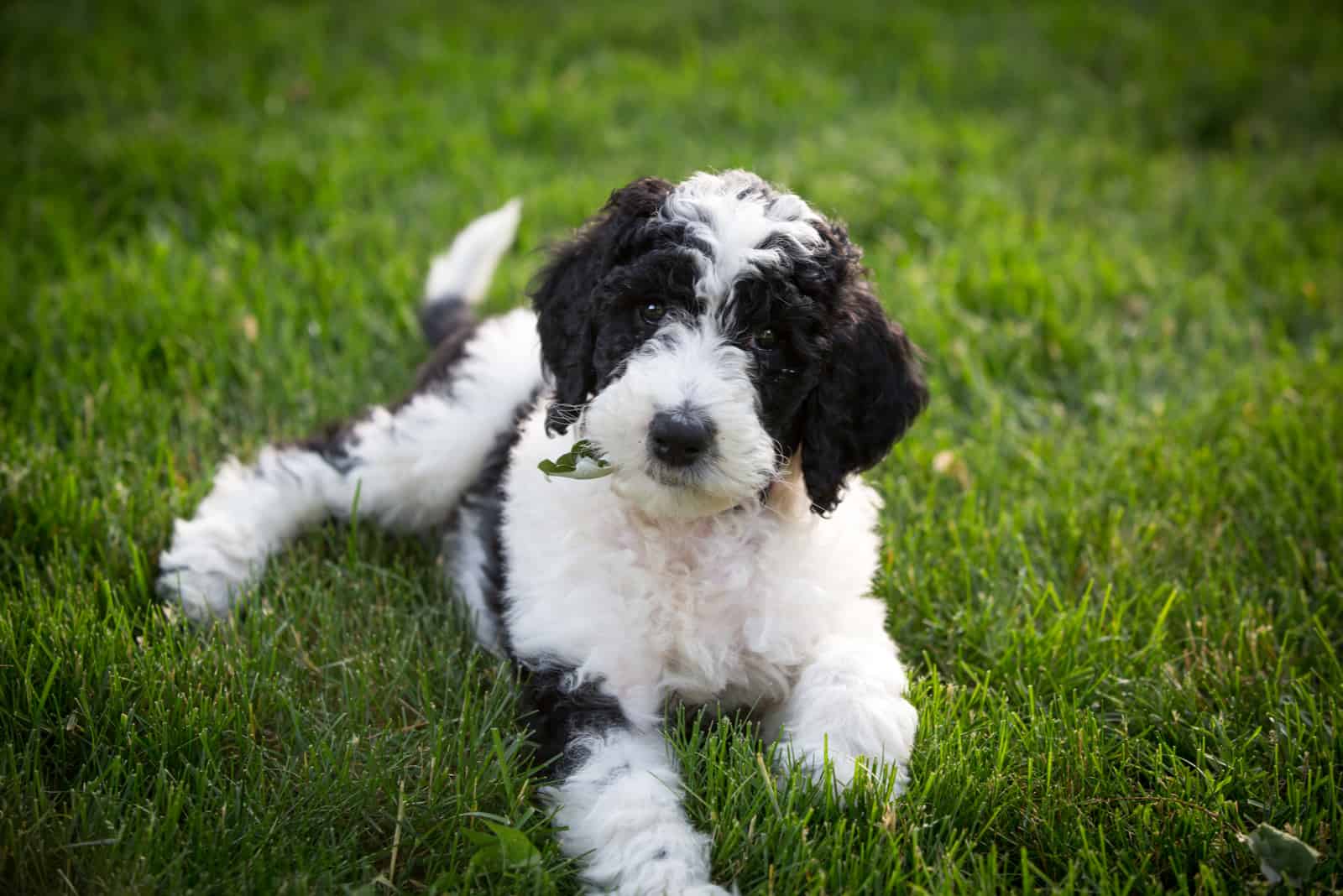
Strictly speaking, they have hair, as the word ‘fur’ usually relates to the undercoat in double-coated breeds. Even so, that wavy or curly hair does have a soft and furry feel!
This gives these goofy furballs a loveable look that matches their temperament perfectly. However, it’s a magnet for twigs, dead leaves, weeds, and all manner of nasty things that attach themselves to it. It can be a nightmare, especially in the fall. Heading off for a walk in the woods? Be prepared for a major brushing session when you get home!
Your dog may well resemble a compost heap or a giant, upturned bird’s nest.
You might guess what’s coming next…
Sheepadoodle Grooming Needs
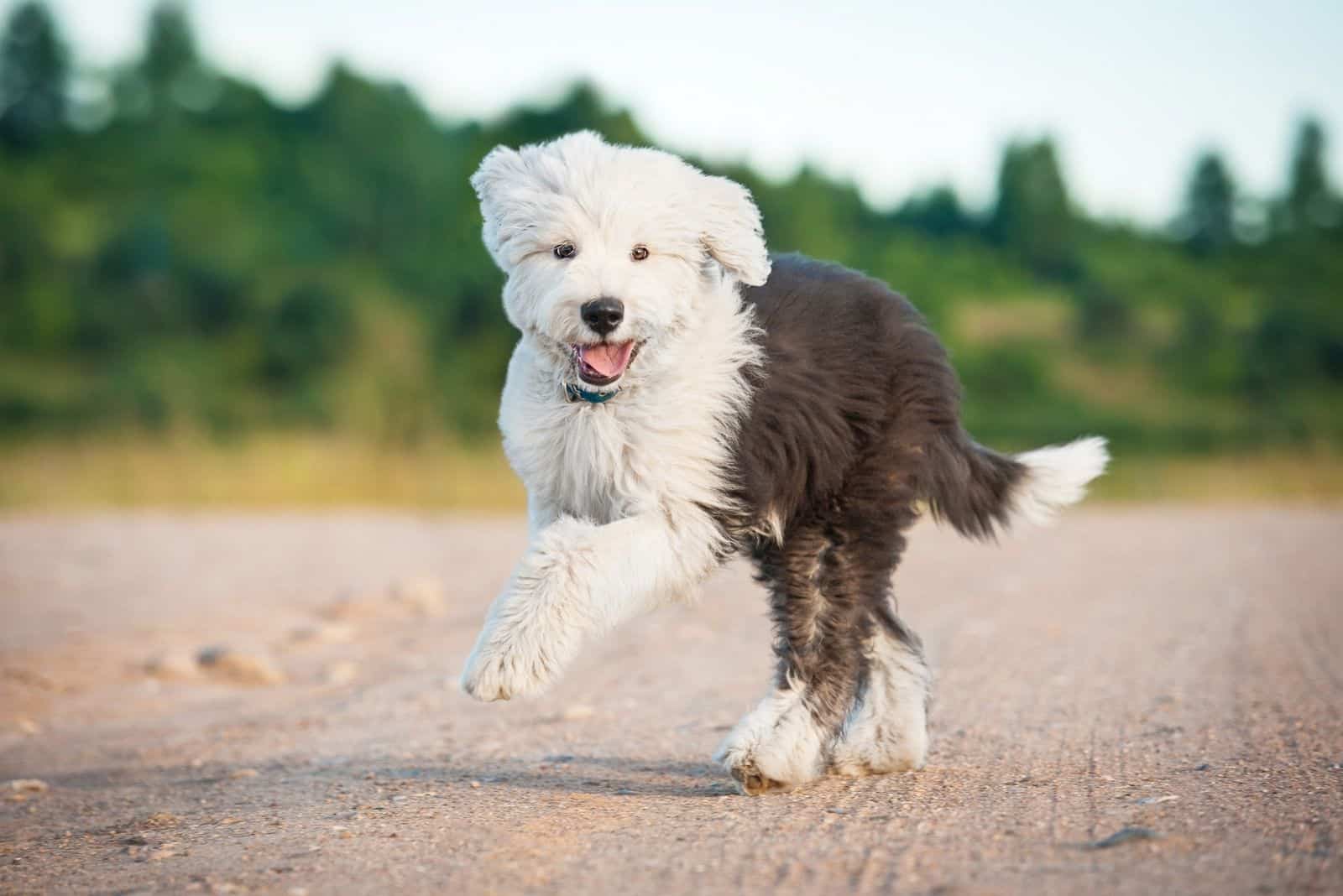
Yes, that coat can be a real pain. It will need brushing at least once or twice a week to get the dead hair out, and extra brushing to get rid of debris. One thing that makes the task easier is that these dogs are good natured and will allow you to get on with it.
To make it more manageable, you might want to employ a professional groomer every three or four weeks. Of course, this is up to you, but a quick trim and a good wash and brush will make your life much easier and keep the coat in excellent condition.
Matting can be a painful problem if the tangles get out of hand. These catch on things as the dog passes, and tug on the skin. They also stop air from reaching the skin as well as trap dirt. This is a recipe for skin infection, which will make your poor pooch’s life a misery.
Unless you’re prepared to commit to regular grooming, possibly daily, then you might want to consider a breed with a short, low-maintenance coat.
Groomers will also clip their toenails for you, and this is essential for keeping their paws in good shape. Nails that grow too long can cause mobility problems as the dog will find it painful to walk.
It’s a job you can do yourself, but you’ll need to take great care.
Those floppy ears add to the teddy bear look, but they can pick up dirt as well as trap excess wax. This is a recipe for infection, so you’ll need to check them frequently and clean them as necessary.
As we have mentioned infections, let’s move on to matters affecting a Sheepadoodle’s health.
Sheepadoodle Health Problems
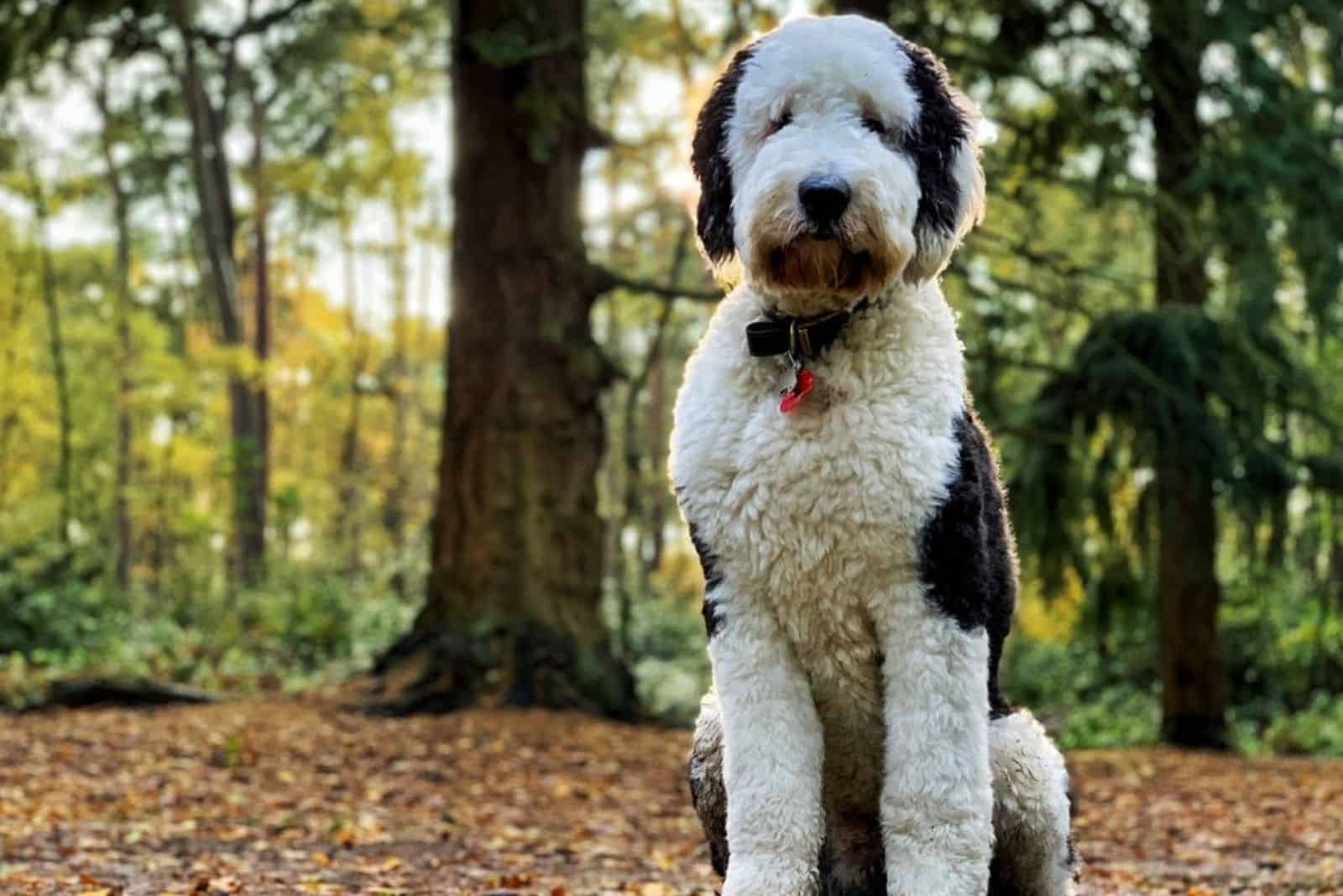
Like most hybrids and mixed breeds, they benefit from hybrid vigor. This is basically the widening of the gene pool, which reduces the chance of certain health issues from being passed on to the offspring, and makes for a much healthier puppy.
Having said this, there are several common health problems that might occur from time to time:
• Addison’s disease – a hormonal disorder relating to the adrenal glands, resulting in a lack of cortisol and aldosterone. This can cause lethargy, weight loss, depression, anorexia, vomiting, and diarrhea. It can also lead to alopecia (hair loss), which makes it pertinent to our question, Do Sheepadoodles shed? It isn’t shedding, as such, but it could affect the volume and frequency of hair loss.
• Cushing’s disease – the opposite of Addison’s disease, this is a result of too much cortisol. The symptoms include an increase in thirst and appetite and a thinning of the skin that causes hair loss.
• Bloat – the medical term for this is gastric dilatation-volvulus (GDV), which is a condition where the stomach swells with gas. It then starts to twist (the volvulus part), which cuts off the blood flow to vital organs. Although the treatment for this condition is generally more advanced these days, it can still be fatal if it isn’t caught soon enough.
• Cancer – many dog breeds are prone to certain types of cancer; some more than others. It’s extremely difficult to predict, so you should always be vigilant. Check your pooch regularly for telltale lumps (not all will be cancerous or malignant!) and take it to the vet at least twice a year for routine examinations.
• Hip dysplasia – a common enough condition in many breeds, this is painful inflammation caused by poorly-formed hip joints. Surgery is frequently used to resolve this and stop the bones from grinding together.
• Sebaceous adenitis – the cause of this inflammatory skin disease isn’t fully understood, but it is also relevant to our main question (Do Sheepadoodles shed?) because it causes a change in the dog’s skin and coat, often leading to alopecia (hair loss). Again, although it isn’t shedding as such, it will still result in dog hair being deposited around the home.
Overall, these are very healthy dogs, with an average lifespan of between 12 and 15 years, so you’ll have plenty of time to get to know your fluffy pooch.
Do Mini Sheepadoodles Shed?
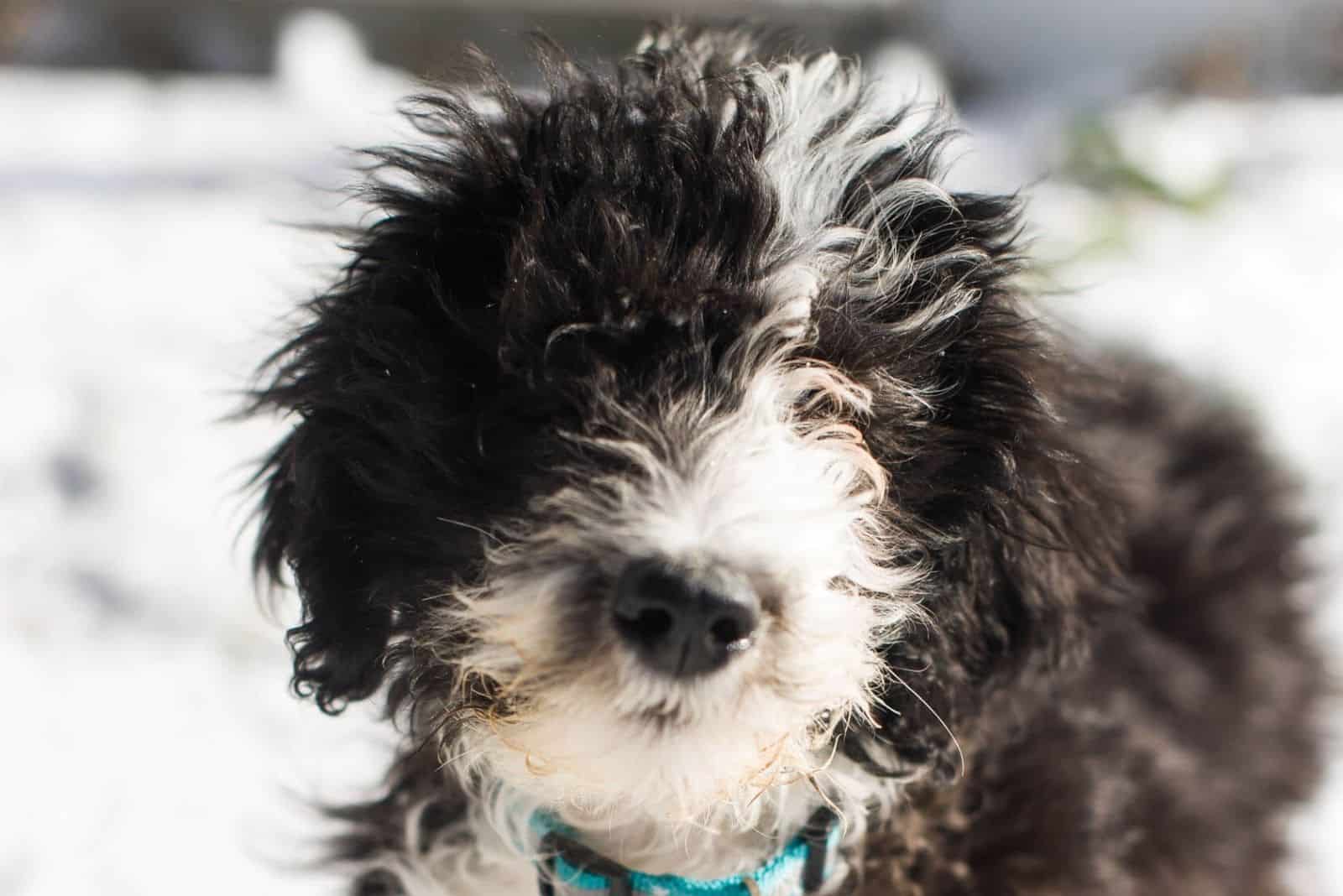
As we have already mentioned, all dogs shed! So, yes, Mini Sheepadoodles will shed some of that hair. They will need regular brushing, but you won’t need to invest in an industrial-strength supercharged pet-hair removing vacuum cleaner. Shedding will be light, but if you keep on top of the grooming routine, you will limit the amount of hair that makes its way onto your furniture.
In all other respects, they are identical to their larger counterparts: just as goofy, just as friendly, and, if anything, even more adorable!
Do Sheepadoodle Puppies Shed?
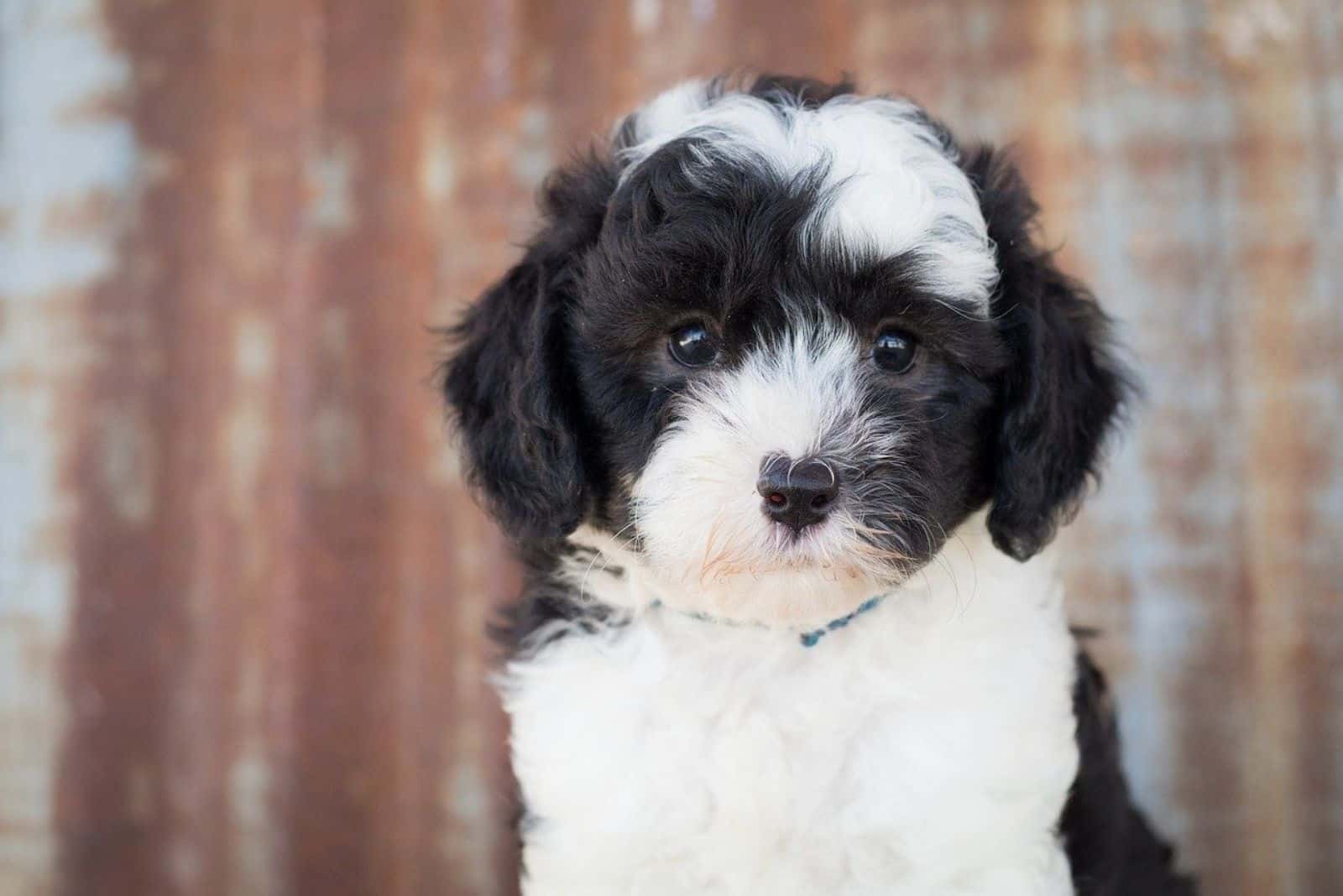
Although we’ve pretty much covered this question by now, it’s worth dealing with puppies separately. All puppies, regardless of breed, will have a special puppy coat. At some stage in their growth, they will lose this coat as the adult one grows in.
In Sheepadoodle puppies, this happens between five and 12 months of age. You’ll know when it happens, as they will shed everywhere.
Do Sheepadoodles shed? Puppies certainly do!
Are Sheepadoodles Good Dogs?
If you’re asking whether they make good family pets, the answer is no… They make brilliant family pets! Seriously, though, they really are good dogs.
Of course, each dog will have its own personality and will inherit certain traits from the parent dogs. All in all, though, this is one of the friendliest, most affectionate breeds you could ask for. They are intelligent, too, and will strive to protect you always.
Above all, they’re as friendly as they look, and will always strive to please you. They’re welcoming to all, and they just want to be your friend. This is seriously one of the best family dogs going.
As always, there are a few rules! All dog owners have a responsibility to ensure that young children aren’t left alone with any dog for long. It isn’t that you don’t or shouldn’t trust the dog. It’s just that accidents can happen. These are high-energy dogs that love to play. Toddlers, babies, or small kids can be bumped out of the way, or playtime can get a bit rough.
Also, the herding instinct sometimes kicks in, and your Sheepapoo might just round up any small humans they see. While that sounds quite cute, there’s a chance that the dog will nip at the kids, as this is a part of the herding process that was bred into them for hundreds of years.
Never fear, though! This behavior can be ‘nipped’ in the bud if you take them to dog training and socialization classes. They are very intelligent and eager to please you, which makes training a breeze.
The instinct to protect their pack (that’s you and your family) is also strong. They make excellent watchdogs and will alert you to anything they see as a threat.
All in all, they are a big, fluffy, goofy, friendly companion who will love you unconditionally, and always have your back.
Read Also: Bernedoodle Vs Sheepadoodle: Which Is The Better Dog Breed
The Final Verdict
Do Sheepadoodles shed? Well, they may do, some more than others. Overall, they are low shedders that shouldn’t be too much of a problem in relation to allergies. You will have to commit to regular brushing, though, to keep that coat in good condition.
But, having seen just how perfect they are in every other way, it doesn’t really seem that important. What matters more is that they are loveable, easy to train, friendly, alert, intelligent, and they are eager to be everybody’s best friend.
Read Next: 11 Best Sheepadoodle Breeders In Ontario
